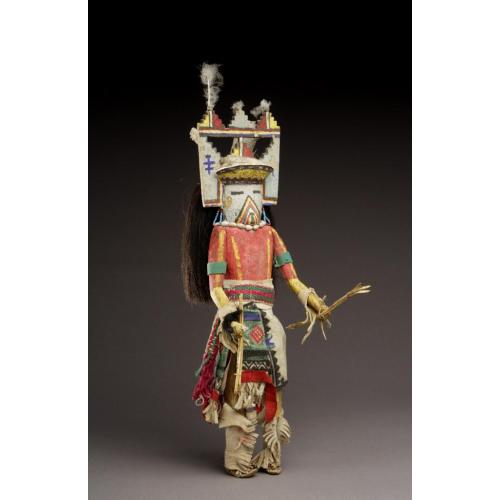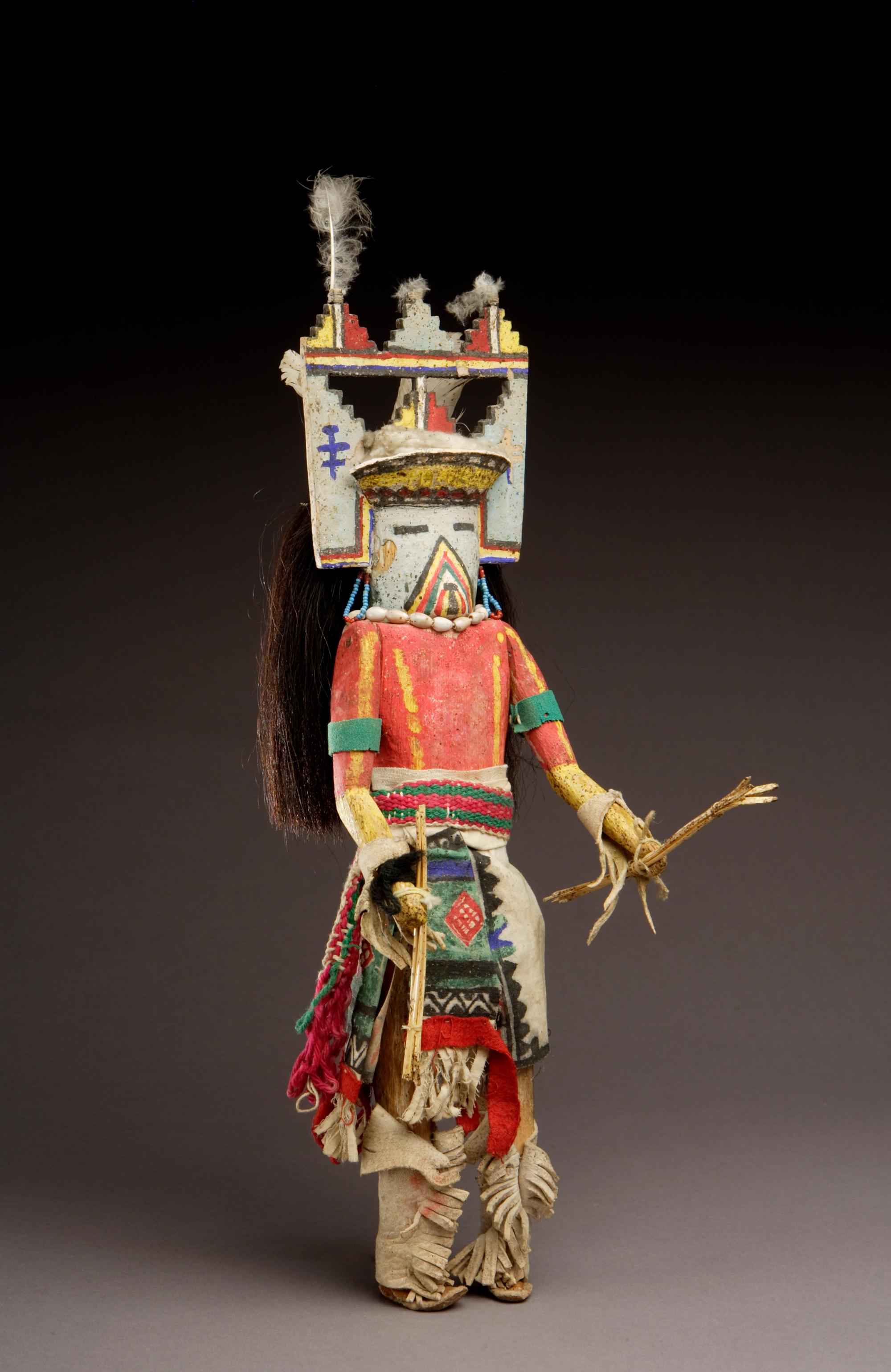
Photograph by Addison Doty. Copyright 2009 School for Advanced Research.
Thlam Hak Du kokko we'ha | Tablita on Head kokko figure
Date: before 1925
Artist or Maker: Unknown
Dimensions:
Overall: 50.8 cm (20 in.)
Medium: wood | paints | feathers | shell, snail | leather | hair | cloth
Credit Line: Obtained by the Indian Arts Fund for the permanent collection; accessioned in 1925.
Place Made:
Zuni Pueblo, McKinley County, New Mexico, Southwest, United States, North America
Object Number: IAF.C4
On view
Tribal Collection Review RemarksJim Enote and Octavius Seowtewa during collection review visit April 6 and 7, 2009 (Events Record “Collection Review: Zuni Tribe, Review 1”): This kokko is part of the Mixed Dance Group and the Helili group. Another version of this kokko is IAF.C330.
ADDITIONAL INFORMATION: Jim Enote and Octavius Seowtewa during collection review visit April 10 and 11, 2014 (Events Record “Collection Review: Zuni Tribe, Review 13”): This kokko is carved from wood, probably pine. Its head and face are painted blue. The eyes are black thin black rectangles. The mouth is also black and is surrounded by a triangle formed from yellow, red, and green lines, outlined with a black line. Just above the kokko’s face is a crown made from painted leather. It’s painted with a row of black and white rectangles at the top and bottom edges, a row of red diamonds and the center is yellow. Above the crown, the kokko’s head is covered with cotton batting. A tablita sits on top of the kokko’s head. It’s painted mostly the same blue as the face, with a blue dragonfly shape on either side of the face. There are two step cloud cutouts just above the top of the head. Above those, the tablita is topped with three more step cloud shapes, painted blue, yellow, red, and white. Each of the three step clouds has a fluffy white feather tied to its top with a piece of waxed string. The back of the tablita is decorated with two painted tadpole shapes. The figure’s hair is made from dark horsehair and extends down to its lower back. The hair is tied on using a technique called “upiłane” in Zuni, which is very time consuming. Two white feathers are nailed to the back of the head. A fan of turkey breast feathers is tied to the bottom of the two white feathers. The figure wears earrings made of blue and red glass beads and a necklace of small snail shells. (The snail shell “necklace” may have originally been intended as the bandolier strap this dancer typically wears.)
The figure’s torso and upper arms are painted red with yellow vertical stripes. The paints are probably commercial poster paints. The arms are articulated at the shoulders and attached to the body with a nail through each shoulder. There is a green felt arm band on each of the figure’s upper arms. Both lower arms also have a natural color leather arm band with fringe on the lower edge. The left hand holds a six-inch bundle consisting of four strips of yucca, which is tied to the hand with a piece of white cotton string. The yucca bundle in the right hand, also tied on with white cotton string, has only three strips in it and may have broken because it’s shorter than the other one. There is a piece of black yarn tied onto the right wrist.
The kilt is made of white cotton muslin, painted to resemble an embroidered dance kilt. A white muslin sash, painted to resemble an embroidered brocade sash, is tied over the top of the kilt. The ends of the sash are edged with red felt. A woven red, green, and white sash belt is tied over top of the brocade sash.
The figure wears tall, handmade moccasins with fringed leg wraps. The moccasins and wraps are made of brain-tanned buckskin.
There are several pieces missing from the kokko’s clothing and some inconsistencies compared to the way a real dancer would be dressed; there should be a turquoise necklace, a bracelet on the right wrist, a bow guard on the left wrist, a shell and juniper berry bandolier strap with a pouch, evergreen sprigs tucked into the top of the kilt, a fox pelt tied over the kilt in back, and bells on the backs of the leg wraps (two on each side). The figure’s legs are the natural color of the wood, but they should be painted white or yellow. While this figure is holding yucca strips in its hands, a real dancer would hold bundles made of bear grass.
In Collection(s)
Bibliography:
Santa Fe Indian Market
- Pg. 137
- Fig. N/A
The Indian Arts Research Center, in collaboration with Native American community scholars, strives to present accurate collections records. Records may be updated as new information becomes available and is reviewed with the Native American community having cultural affinity to particular items. Please write to iarc@sarsf.org if you have questions or concerns related to the documentation.
